Australian Catholic University HLSC605 Reflective Essay
VerifiedAdded on 2022/09/17
|9
|2202
|21
Essay
AI Summary
This reflective essay, written for the HLSC605 Leadership in Health Care course at Australian Catholic University, explores a planned change within the Royal Melbourne Hospital's emergency surgical ward. The essay begins by establishing a theoretical basis for the change, emphasizing innovation and the application of change theory. It then delves into the importance of effective communication, highlighting procedures developed to involve patients, families, and medical staff, as well as the role of verbal and non-verbal interactions. The essay also examines resistance to change from both patients and medical staff, analyzing factors such as unfamiliarity with new technologies and treatment costs. Finally, it discusses ethical leadership, focusing on ethical principles, decision-making, and the importance of team spirit and participatory leadership styles in fostering positive outcomes. The author reflects on the learning experience and its implications for their professional practice.
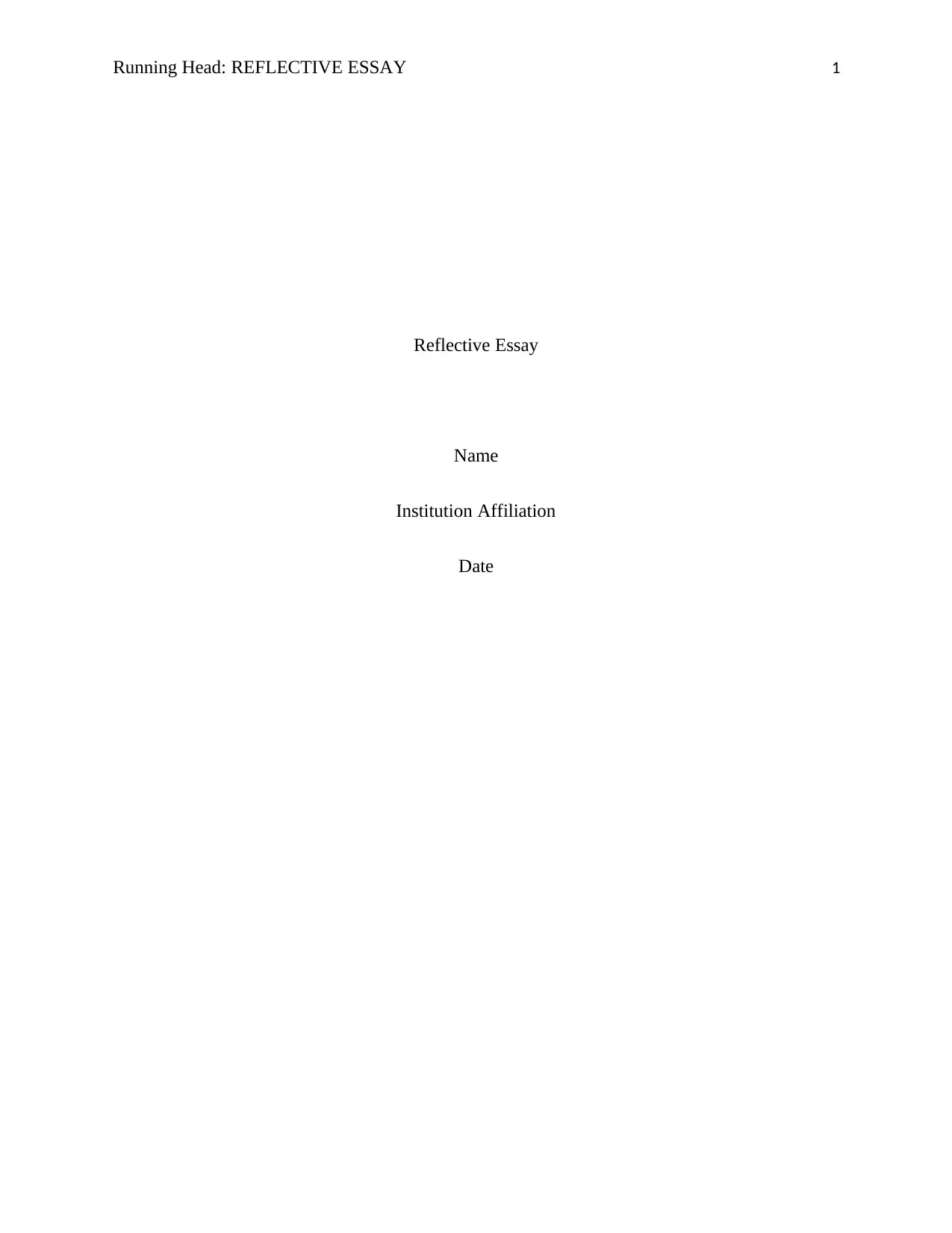
Running Head: REFLECTIVE ESSAY 1
Reflective Essay
Name
Institution Affiliation
Date
Reflective Essay
Name
Institution Affiliation
Date
Paraphrase This Document
Need a fresh take? Get an instant paraphrase of this document with our AI Paraphraser
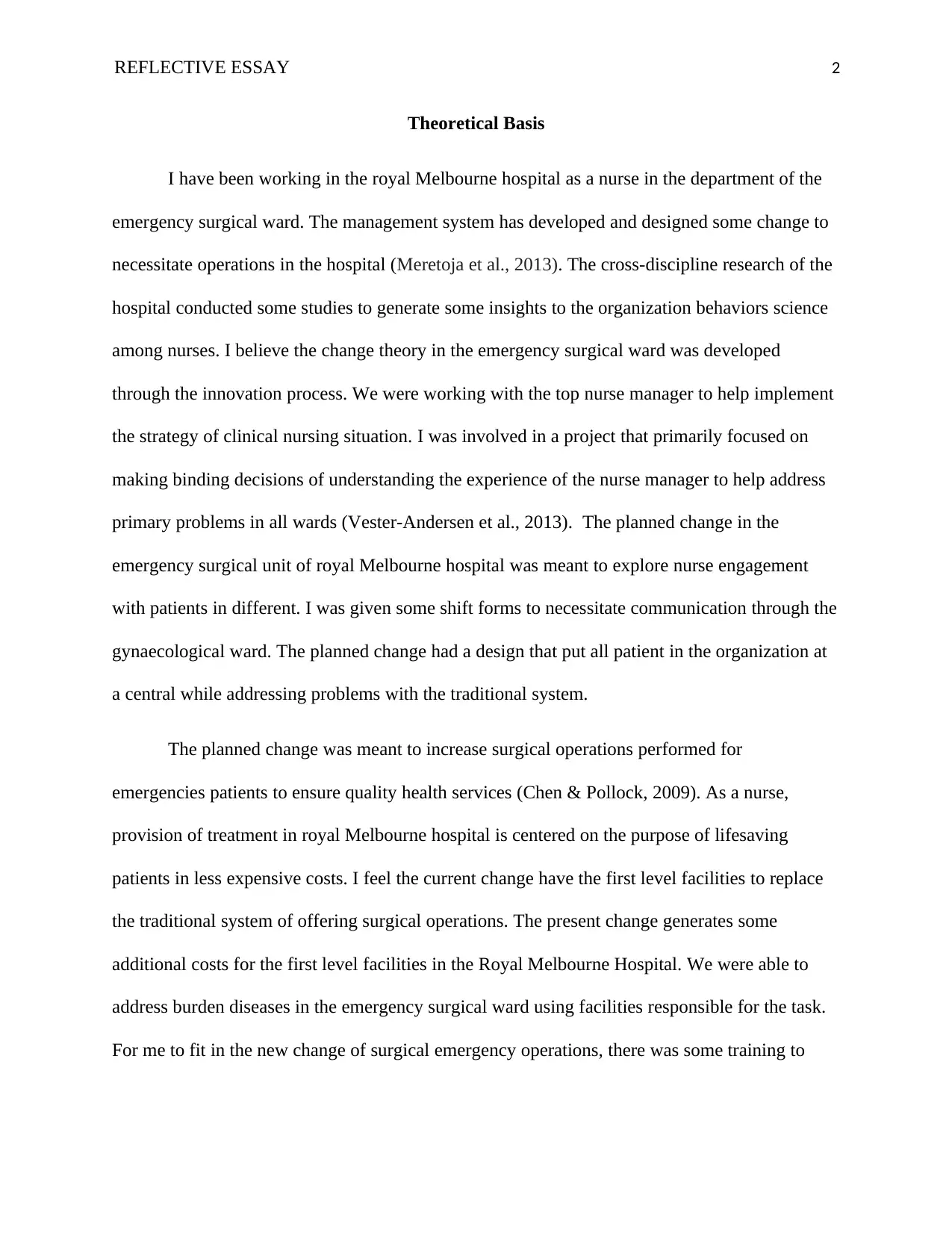
REFLECTIVE ESSAY 2
Theoretical Basis
I have been working in the royal Melbourne hospital as a nurse in the department of the
emergency surgical ward. The management system has developed and designed some change to
necessitate operations in the hospital (Meretoja et al., 2013). The cross-discipline research of the
hospital conducted some studies to generate some insights to the organization behaviors science
among nurses. I believe the change theory in the emergency surgical ward was developed
through the innovation process. We were working with the top nurse manager to help implement
the strategy of clinical nursing situation. I was involved in a project that primarily focused on
making binding decisions of understanding the experience of the nurse manager to help address
primary problems in all wards (Vester-Andersen et al., 2013). The planned change in the
emergency surgical unit of royal Melbourne hospital was meant to explore nurse engagement
with patients in different. I was given some shift forms to necessitate communication through the
gynaecological ward. The planned change had a design that put all patient in the organization at
a central while addressing problems with the traditional system.
The planned change was meant to increase surgical operations performed for
emergencies patients to ensure quality health services (Chen & Pollock, 2009). As a nurse,
provision of treatment in royal Melbourne hospital is centered on the purpose of lifesaving
patients in less expensive costs. I feel the current change have the first level facilities to replace
the traditional system of offering surgical operations. The present change generates some
additional costs for the first level facilities in the Royal Melbourne Hospital. We were able to
address burden diseases in the emergency surgical ward using facilities responsible for the task.
For me to fit in the new change of surgical emergency operations, there was some training to
Theoretical Basis
I have been working in the royal Melbourne hospital as a nurse in the department of the
emergency surgical ward. The management system has developed and designed some change to
necessitate operations in the hospital (Meretoja et al., 2013). The cross-discipline research of the
hospital conducted some studies to generate some insights to the organization behaviors science
among nurses. I believe the change theory in the emergency surgical ward was developed
through the innovation process. We were working with the top nurse manager to help implement
the strategy of clinical nursing situation. I was involved in a project that primarily focused on
making binding decisions of understanding the experience of the nurse manager to help address
primary problems in all wards (Vester-Andersen et al., 2013). The planned change in the
emergency surgical unit of royal Melbourne hospital was meant to explore nurse engagement
with patients in different. I was given some shift forms to necessitate communication through the
gynaecological ward. The planned change had a design that put all patient in the organization at
a central while addressing problems with the traditional system.
The planned change was meant to increase surgical operations performed for
emergencies patients to ensure quality health services (Chen & Pollock, 2009). As a nurse,
provision of treatment in royal Melbourne hospital is centered on the purpose of lifesaving
patients in less expensive costs. I feel the current change have the first level facilities to replace
the traditional system of offering surgical operations. The present change generates some
additional costs for the first level facilities in the Royal Melbourne Hospital. We were able to
address burden diseases in the emergency surgical ward using facilities responsible for the task.
For me to fit in the new change of surgical emergency operations, there was some training to
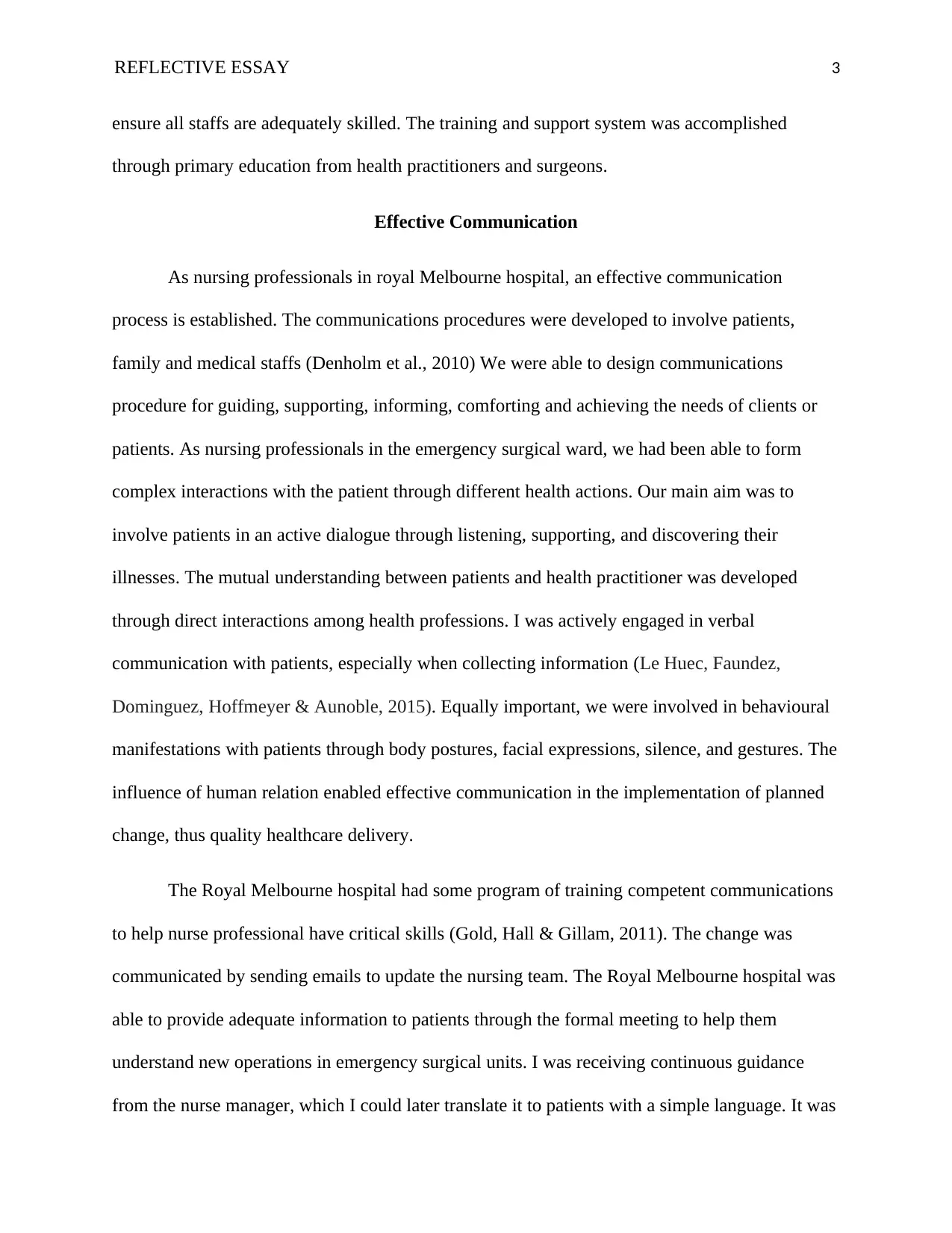
REFLECTIVE ESSAY 3
ensure all staffs are adequately skilled. The training and support system was accomplished
through primary education from health practitioners and surgeons.
Effective Communication
As nursing professionals in royal Melbourne hospital, an effective communication
process is established. The communications procedures were developed to involve patients,
family and medical staffs (Denholm et al., 2010) We were able to design communications
procedure for guiding, supporting, informing, comforting and achieving the needs of clients or
patients. As nursing professionals in the emergency surgical ward, we had been able to form
complex interactions with the patient through different health actions. Our main aim was to
involve patients in an active dialogue through listening, supporting, and discovering their
illnesses. The mutual understanding between patients and health practitioner was developed
through direct interactions among health professions. I was actively engaged in verbal
communication with patients, especially when collecting information (Le Huec, Faundez,
Dominguez, Hoffmeyer & Aunoble, 2015). Equally important, we were involved in behavioural
manifestations with patients through body postures, facial expressions, silence, and gestures. The
influence of human relation enabled effective communication in the implementation of planned
change, thus quality healthcare delivery.
The Royal Melbourne hospital had some program of training competent communications
to help nurse professional have critical skills (Gold, Hall & Gillam, 2011). The change was
communicated by sending emails to update the nursing team. The Royal Melbourne hospital was
able to provide adequate information to patients through the formal meeting to help them
understand new operations in emergency surgical units. I was receiving continuous guidance
from the nurse manager, which I could later translate it to patients with a simple language. It was
ensure all staffs are adequately skilled. The training and support system was accomplished
through primary education from health practitioners and surgeons.
Effective Communication
As nursing professionals in royal Melbourne hospital, an effective communication
process is established. The communications procedures were developed to involve patients,
family and medical staffs (Denholm et al., 2010) We were able to design communications
procedure for guiding, supporting, informing, comforting and achieving the needs of clients or
patients. As nursing professionals in the emergency surgical ward, we had been able to form
complex interactions with the patient through different health actions. Our main aim was to
involve patients in an active dialogue through listening, supporting, and discovering their
illnesses. The mutual understanding between patients and health practitioner was developed
through direct interactions among health professions. I was actively engaged in verbal
communication with patients, especially when collecting information (Le Huec, Faundez,
Dominguez, Hoffmeyer & Aunoble, 2015). Equally important, we were involved in behavioural
manifestations with patients through body postures, facial expressions, silence, and gestures. The
influence of human relation enabled effective communication in the implementation of planned
change, thus quality healthcare delivery.
The Royal Melbourne hospital had some program of training competent communications
to help nurse professional have critical skills (Gold, Hall & Gillam, 2011). The change was
communicated by sending emails to update the nursing team. The Royal Melbourne hospital was
able to provide adequate information to patients through the formal meeting to help them
understand new operations in emergency surgical units. I was receiving continuous guidance
from the nurse manager, which I could later translate it to patients with a simple language. It was
⊘ This is a preview!⊘
Do you want full access?
Subscribe today to unlock all pages.

Trusted by 1+ million students worldwide
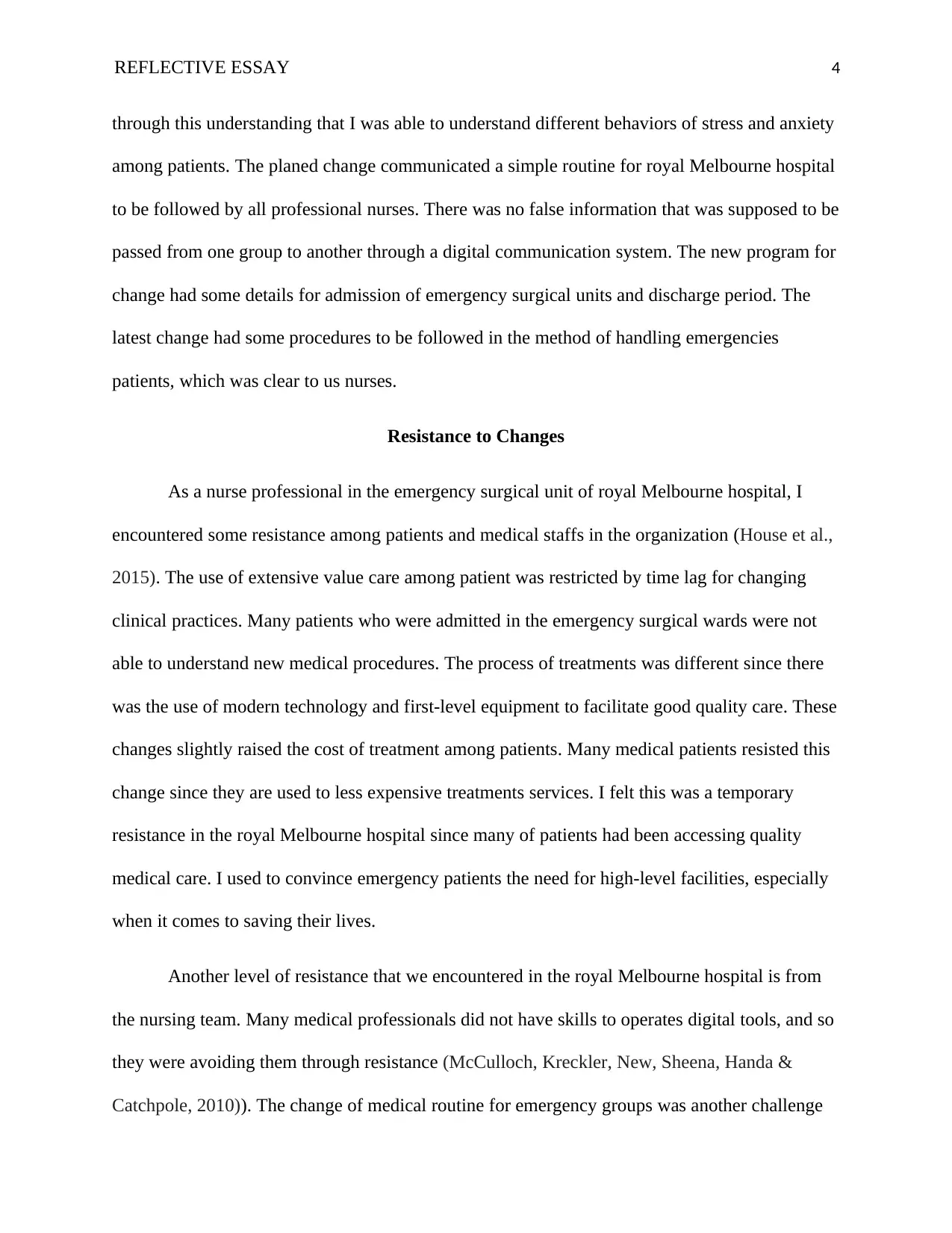
REFLECTIVE ESSAY 4
through this understanding that I was able to understand different behaviors of stress and anxiety
among patients. The planed change communicated a simple routine for royal Melbourne hospital
to be followed by all professional nurses. There was no false information that was supposed to be
passed from one group to another through a digital communication system. The new program for
change had some details for admission of emergency surgical units and discharge period. The
latest change had some procedures to be followed in the method of handling emergencies
patients, which was clear to us nurses.
Resistance to Changes
As a nurse professional in the emergency surgical unit of royal Melbourne hospital, I
encountered some resistance among patients and medical staffs in the organization (House et al.,
2015). The use of extensive value care among patient was restricted by time lag for changing
clinical practices. Many patients who were admitted in the emergency surgical wards were not
able to understand new medical procedures. The process of treatments was different since there
was the use of modern technology and first-level equipment to facilitate good quality care. These
changes slightly raised the cost of treatment among patients. Many medical patients resisted this
change since they are used to less expensive treatments services. I felt this was a temporary
resistance in the royal Melbourne hospital since many of patients had been accessing quality
medical care. I used to convince emergency patients the need for high-level facilities, especially
when it comes to saving their lives.
Another level of resistance that we encountered in the royal Melbourne hospital is from
the nursing team. Many medical professionals did not have skills to operates digital tools, and so
they were avoiding them through resistance (McCulloch, Kreckler, New, Sheena, Handa &
Catchpole, 2010)). The change of medical routine for emergency groups was another challenge
through this understanding that I was able to understand different behaviors of stress and anxiety
among patients. The planed change communicated a simple routine for royal Melbourne hospital
to be followed by all professional nurses. There was no false information that was supposed to be
passed from one group to another through a digital communication system. The new program for
change had some details for admission of emergency surgical units and discharge period. The
latest change had some procedures to be followed in the method of handling emergencies
patients, which was clear to us nurses.
Resistance to Changes
As a nurse professional in the emergency surgical unit of royal Melbourne hospital, I
encountered some resistance among patients and medical staffs in the organization (House et al.,
2015). The use of extensive value care among patient was restricted by time lag for changing
clinical practices. Many patients who were admitted in the emergency surgical wards were not
able to understand new medical procedures. The process of treatments was different since there
was the use of modern technology and first-level equipment to facilitate good quality care. These
changes slightly raised the cost of treatment among patients. Many medical patients resisted this
change since they are used to less expensive treatments services. I felt this was a temporary
resistance in the royal Melbourne hospital since many of patients had been accessing quality
medical care. I used to convince emergency patients the need for high-level facilities, especially
when it comes to saving their lives.
Another level of resistance that we encountered in the royal Melbourne hospital is from
the nursing team. Many medical professionals did not have skills to operates digital tools, and so
they were avoiding them through resistance (McCulloch, Kreckler, New, Sheena, Handa &
Catchpole, 2010)). The change of medical routine for emergency groups was another challenge
Paraphrase This Document
Need a fresh take? Get an instant paraphrase of this document with our AI Paraphraser
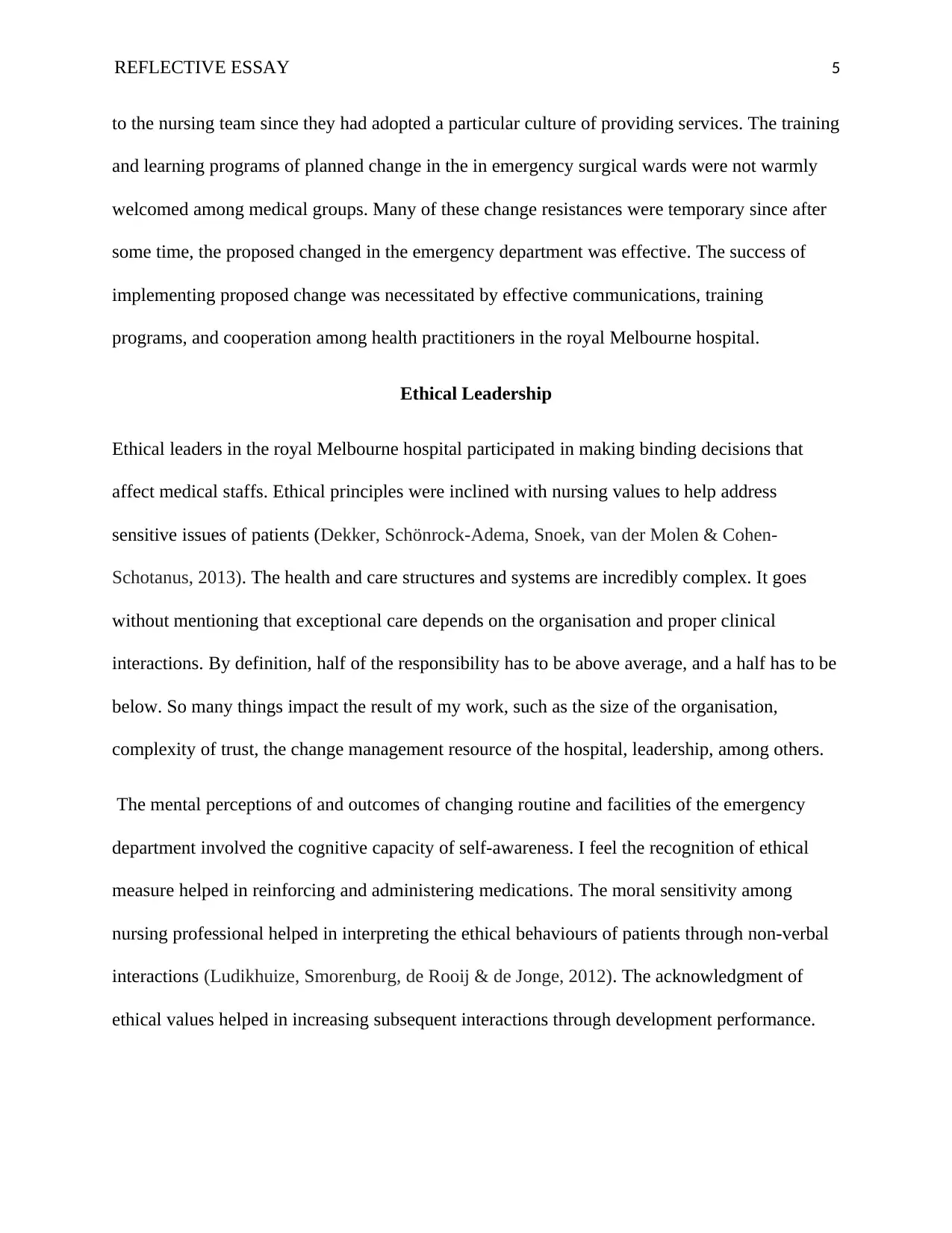
REFLECTIVE ESSAY 5
to the nursing team since they had adopted a particular culture of providing services. The training
and learning programs of planned change in the in emergency surgical wards were not warmly
welcomed among medical groups. Many of these change resistances were temporary since after
some time, the proposed changed in the emergency department was effective. The success of
implementing proposed change was necessitated by effective communications, training
programs, and cooperation among health practitioners in the royal Melbourne hospital.
Ethical Leadership
Ethical leaders in the royal Melbourne hospital participated in making binding decisions that
affect medical staffs. Ethical principles were inclined with nursing values to help address
sensitive issues of patients (Dekker, Schönrock-Adema, Snoek, van der Molen & Cohen-
Schotanus, 2013). The health and care structures and systems are incredibly complex. It goes
without mentioning that exceptional care depends on the organisation and proper clinical
interactions. By definition, half of the responsibility has to be above average, and a half has to be
below. So many things impact the result of my work, such as the size of the organisation,
complexity of trust, the change management resource of the hospital, leadership, among others.
The mental perceptions of and outcomes of changing routine and facilities of the emergency
department involved the cognitive capacity of self-awareness. I feel the recognition of ethical
measure helped in reinforcing and administering medications. The moral sensitivity among
nursing professional helped in interpreting the ethical behaviours of patients through non-verbal
interactions (Ludikhuize, Smorenburg, de Rooij & de Jonge, 2012). The acknowledgment of
ethical values helped in increasing subsequent interactions through development performance.
to the nursing team since they had adopted a particular culture of providing services. The training
and learning programs of planned change in the in emergency surgical wards were not warmly
welcomed among medical groups. Many of these change resistances were temporary since after
some time, the proposed changed in the emergency department was effective. The success of
implementing proposed change was necessitated by effective communications, training
programs, and cooperation among health practitioners in the royal Melbourne hospital.
Ethical Leadership
Ethical leaders in the royal Melbourne hospital participated in making binding decisions that
affect medical staffs. Ethical principles were inclined with nursing values to help address
sensitive issues of patients (Dekker, Schönrock-Adema, Snoek, van der Molen & Cohen-
Schotanus, 2013). The health and care structures and systems are incredibly complex. It goes
without mentioning that exceptional care depends on the organisation and proper clinical
interactions. By definition, half of the responsibility has to be above average, and a half has to be
below. So many things impact the result of my work, such as the size of the organisation,
complexity of trust, the change management resource of the hospital, leadership, among others.
The mental perceptions of and outcomes of changing routine and facilities of the emergency
department involved the cognitive capacity of self-awareness. I feel the recognition of ethical
measure helped in reinforcing and administering medications. The moral sensitivity among
nursing professional helped in interpreting the ethical behaviours of patients through non-verbal
interactions (Ludikhuize, Smorenburg, de Rooij & de Jonge, 2012). The acknowledgment of
ethical values helped in increasing subsequent interactions through development performance.
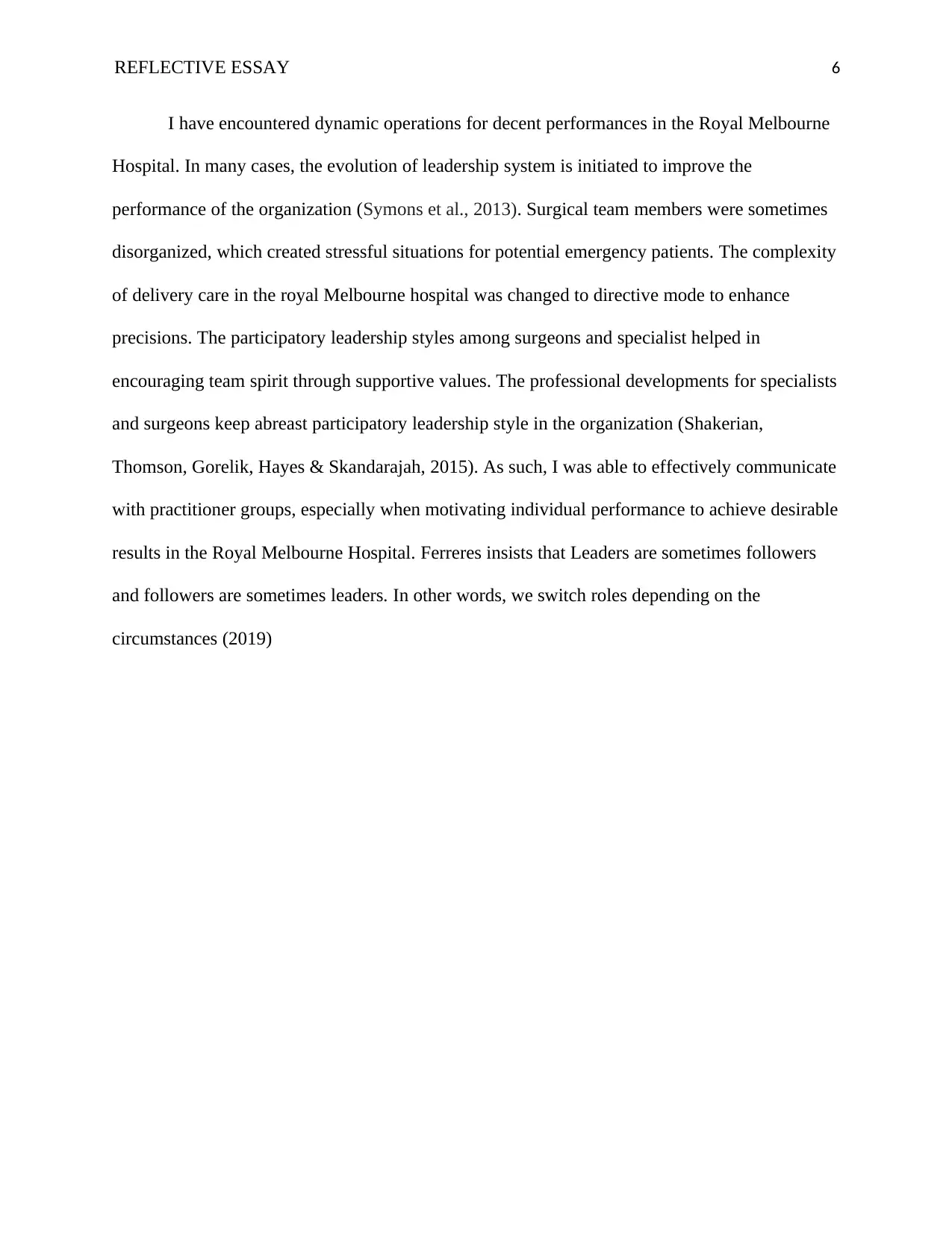
REFLECTIVE ESSAY 6
I have encountered dynamic operations for decent performances in the Royal Melbourne
Hospital. In many cases, the evolution of leadership system is initiated to improve the
performance of the organization (Symons et al., 2013). Surgical team members were sometimes
disorganized, which created stressful situations for potential emergency patients. The complexity
of delivery care in the royal Melbourne hospital was changed to directive mode to enhance
precisions. The participatory leadership styles among surgeons and specialist helped in
encouraging team spirit through supportive values. The professional developments for specialists
and surgeons keep abreast participatory leadership style in the organization (Shakerian,
Thomson, Gorelik, Hayes & Skandarajah, 2015). As such, I was able to effectively communicate
with practitioner groups, especially when motivating individual performance to achieve desirable
results in the Royal Melbourne Hospital. Ferreres insists that Leaders are sometimes followers
and followers are sometimes leaders. In other words, we switch roles depending on the
circumstances (2019)
I have encountered dynamic operations for decent performances in the Royal Melbourne
Hospital. In many cases, the evolution of leadership system is initiated to improve the
performance of the organization (Symons et al., 2013). Surgical team members were sometimes
disorganized, which created stressful situations for potential emergency patients. The complexity
of delivery care in the royal Melbourne hospital was changed to directive mode to enhance
precisions. The participatory leadership styles among surgeons and specialist helped in
encouraging team spirit through supportive values. The professional developments for specialists
and surgeons keep abreast participatory leadership style in the organization (Shakerian,
Thomson, Gorelik, Hayes & Skandarajah, 2015). As such, I was able to effectively communicate
with practitioner groups, especially when motivating individual performance to achieve desirable
results in the Royal Melbourne Hospital. Ferreres insists that Leaders are sometimes followers
and followers are sometimes leaders. In other words, we switch roles depending on the
circumstances (2019)
⊘ This is a preview!⊘
Do you want full access?
Subscribe today to unlock all pages.

Trusted by 1+ million students worldwide
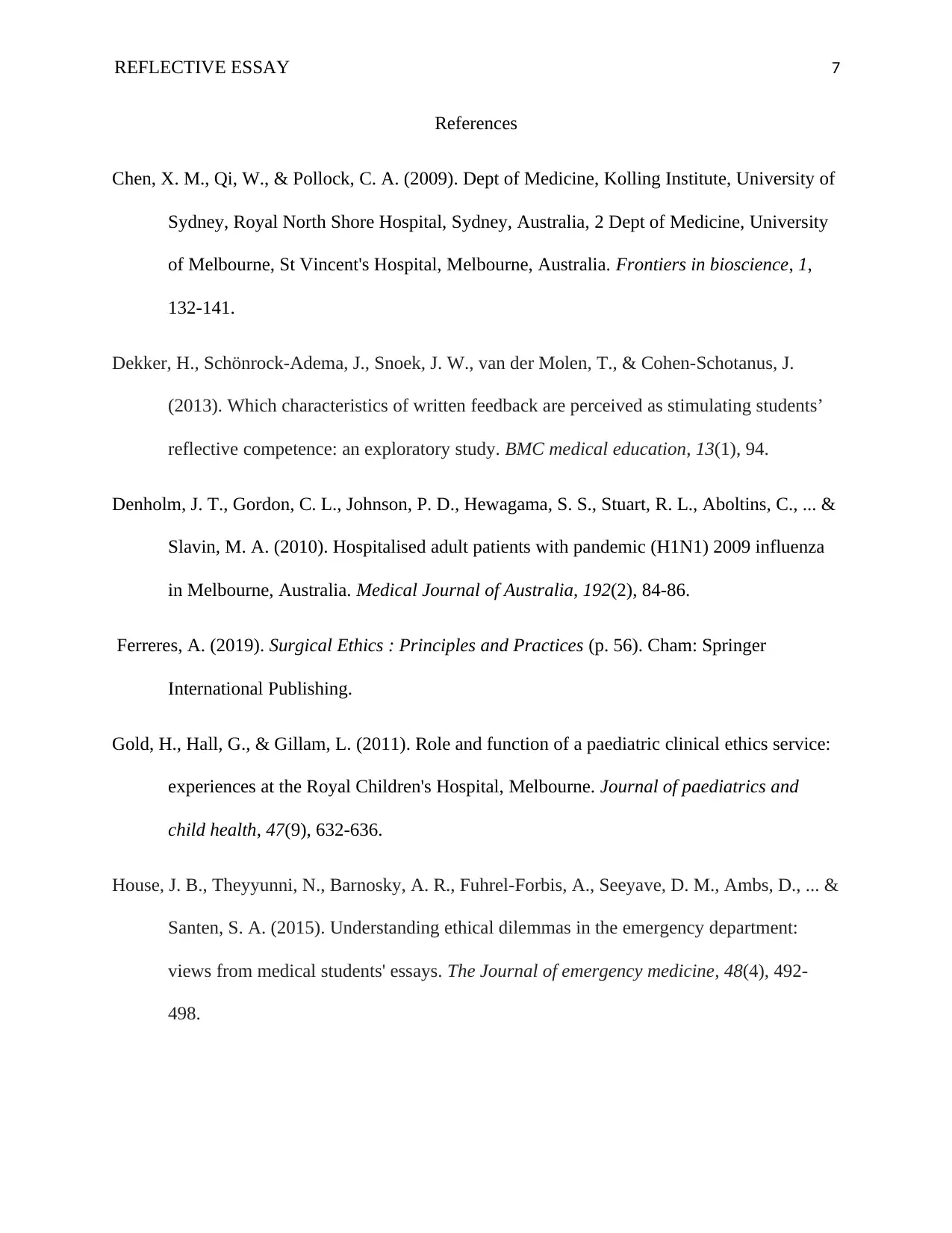
REFLECTIVE ESSAY 7
References
Chen, X. M., Qi, W., & Pollock, C. A. (2009). Dept of Medicine, Kolling Institute, University of
Sydney, Royal North Shore Hospital, Sydney, Australia, 2 Dept of Medicine, University
of Melbourne, St Vincent's Hospital, Melbourne, Australia. Frontiers in bioscience, 1,
132-141.
Dekker, H., Schönrock-Adema, J., Snoek, J. W., van der Molen, T., & Cohen-Schotanus, J.
(2013). Which characteristics of written feedback are perceived as stimulating students’
reflective competence: an exploratory study. BMC medical education, 13(1), 94.
Denholm, J. T., Gordon, C. L., Johnson, P. D., Hewagama, S. S., Stuart, R. L., Aboltins, C., ... &
Slavin, M. A. (2010). Hospitalised adult patients with pandemic (H1N1) 2009 influenza
in Melbourne, Australia. Medical Journal of Australia, 192(2), 84-86.
Ferreres, A. (2019). Surgical Ethics : Principles and Practices (p. 56). Cham: Springer
International Publishing.
Gold, H., Hall, G., & Gillam, L. (2011). Role and function of a paediatric clinical ethics service:
experiences at the Royal Children's Hospital, Melbourne. Journal of paediatrics and
child health, 47(9), 632-636.
House, J. B., Theyyunni, N., Barnosky, A. R., Fuhrel-Forbis, A., Seeyave, D. M., Ambs, D., ... &
Santen, S. A. (2015). Understanding ethical dilemmas in the emergency department:
views from medical students' essays. The Journal of emergency medicine, 48(4), 492-
498.
References
Chen, X. M., Qi, W., & Pollock, C. A. (2009). Dept of Medicine, Kolling Institute, University of
Sydney, Royal North Shore Hospital, Sydney, Australia, 2 Dept of Medicine, University
of Melbourne, St Vincent's Hospital, Melbourne, Australia. Frontiers in bioscience, 1,
132-141.
Dekker, H., Schönrock-Adema, J., Snoek, J. W., van der Molen, T., & Cohen-Schotanus, J.
(2013). Which characteristics of written feedback are perceived as stimulating students’
reflective competence: an exploratory study. BMC medical education, 13(1), 94.
Denholm, J. T., Gordon, C. L., Johnson, P. D., Hewagama, S. S., Stuart, R. L., Aboltins, C., ... &
Slavin, M. A. (2010). Hospitalised adult patients with pandemic (H1N1) 2009 influenza
in Melbourne, Australia. Medical Journal of Australia, 192(2), 84-86.
Ferreres, A. (2019). Surgical Ethics : Principles and Practices (p. 56). Cham: Springer
International Publishing.
Gold, H., Hall, G., & Gillam, L. (2011). Role and function of a paediatric clinical ethics service:
experiences at the Royal Children's Hospital, Melbourne. Journal of paediatrics and
child health, 47(9), 632-636.
House, J. B., Theyyunni, N., Barnosky, A. R., Fuhrel-Forbis, A., Seeyave, D. M., Ambs, D., ... &
Santen, S. A. (2015). Understanding ethical dilemmas in the emergency department:
views from medical students' essays. The Journal of emergency medicine, 48(4), 492-
498.
Paraphrase This Document
Need a fresh take? Get an instant paraphrase of this document with our AI Paraphraser
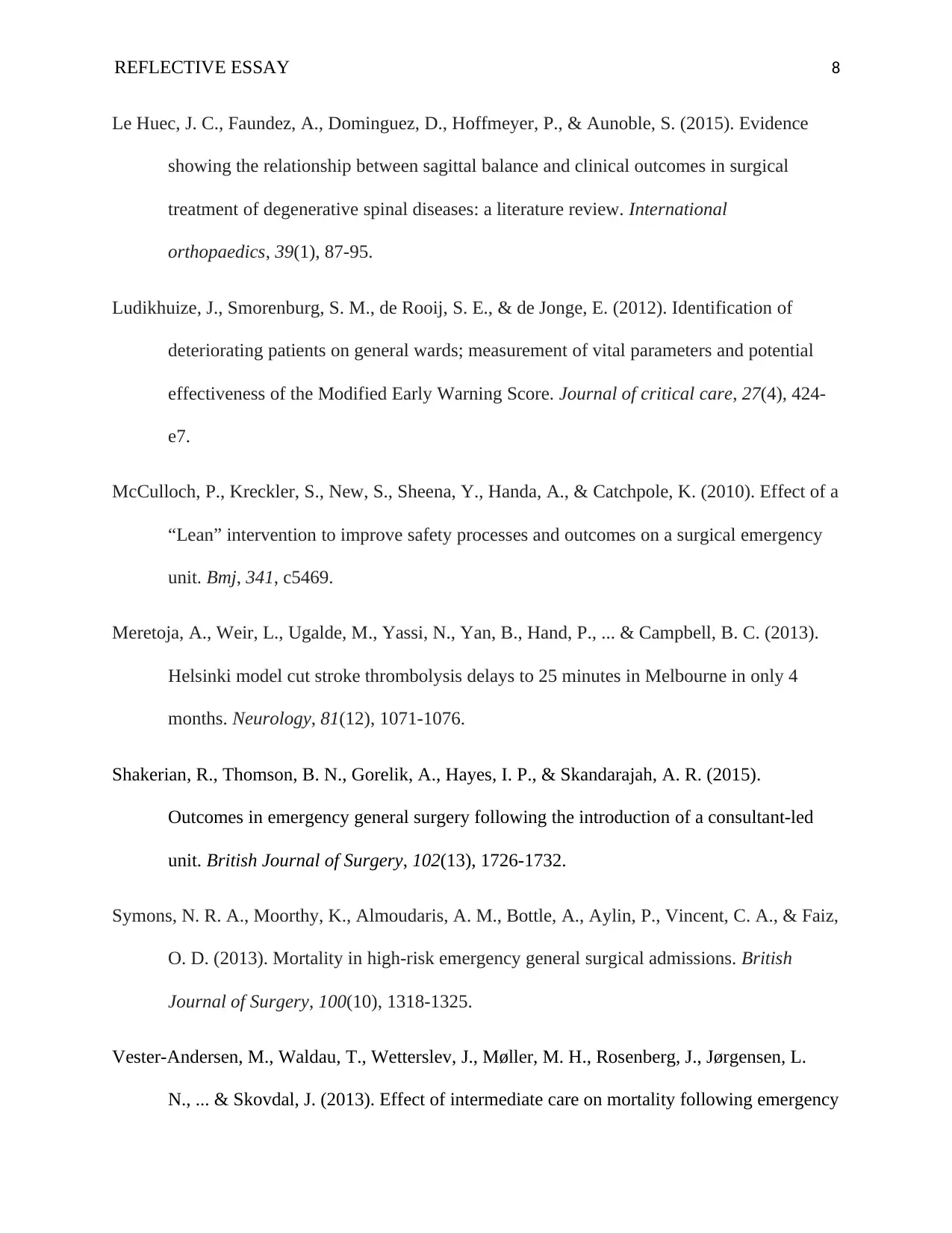
REFLECTIVE ESSAY 8
Le Huec, J. C., Faundez, A., Dominguez, D., Hoffmeyer, P., & Aunoble, S. (2015). Evidence
showing the relationship between sagittal balance and clinical outcomes in surgical
treatment of degenerative spinal diseases: a literature review. International
orthopaedics, 39(1), 87-95.
Ludikhuize, J., Smorenburg, S. M., de Rooij, S. E., & de Jonge, E. (2012). Identification of
deteriorating patients on general wards; measurement of vital parameters and potential
effectiveness of the Modified Early Warning Score. Journal of critical care, 27(4), 424-
e7.
McCulloch, P., Kreckler, S., New, S., Sheena, Y., Handa, A., & Catchpole, K. (2010). Effect of a
“Lean” intervention to improve safety processes and outcomes on a surgical emergency
unit. Bmj, 341, c5469.
Meretoja, A., Weir, L., Ugalde, M., Yassi, N., Yan, B., Hand, P., ... & Campbell, B. C. (2013).
Helsinki model cut stroke thrombolysis delays to 25 minutes in Melbourne in only 4
months. Neurology, 81(12), 1071-1076.
Shakerian, R., Thomson, B. N., Gorelik, A., Hayes, I. P., & Skandarajah, A. R. (2015).
Outcomes in emergency general surgery following the introduction of a consultant‐led
unit. British Journal of Surgery, 102(13), 1726-1732.
Symons, N. R. A., Moorthy, K., Almoudaris, A. M., Bottle, A., Aylin, P., Vincent, C. A., & Faiz,
O. D. (2013). Mortality in high‐risk emergency general surgical admissions. British
Journal of Surgery, 100(10), 1318-1325.
Vester-Andersen, M., Waldau, T., Wetterslev, J., Møller, M. H., Rosenberg, J., Jørgensen, L.
N., ... & Skovdal, J. (2013). Effect of intermediate care on mortality following emergency
Le Huec, J. C., Faundez, A., Dominguez, D., Hoffmeyer, P., & Aunoble, S. (2015). Evidence
showing the relationship between sagittal balance and clinical outcomes in surgical
treatment of degenerative spinal diseases: a literature review. International
orthopaedics, 39(1), 87-95.
Ludikhuize, J., Smorenburg, S. M., de Rooij, S. E., & de Jonge, E. (2012). Identification of
deteriorating patients on general wards; measurement of vital parameters and potential
effectiveness of the Modified Early Warning Score. Journal of critical care, 27(4), 424-
e7.
McCulloch, P., Kreckler, S., New, S., Sheena, Y., Handa, A., & Catchpole, K. (2010). Effect of a
“Lean” intervention to improve safety processes and outcomes on a surgical emergency
unit. Bmj, 341, c5469.
Meretoja, A., Weir, L., Ugalde, M., Yassi, N., Yan, B., Hand, P., ... & Campbell, B. C. (2013).
Helsinki model cut stroke thrombolysis delays to 25 minutes in Melbourne in only 4
months. Neurology, 81(12), 1071-1076.
Shakerian, R., Thomson, B. N., Gorelik, A., Hayes, I. P., & Skandarajah, A. R. (2015).
Outcomes in emergency general surgery following the introduction of a consultant‐led
unit. British Journal of Surgery, 102(13), 1726-1732.
Symons, N. R. A., Moorthy, K., Almoudaris, A. M., Bottle, A., Aylin, P., Vincent, C. A., & Faiz,
O. D. (2013). Mortality in high‐risk emergency general surgical admissions. British
Journal of Surgery, 100(10), 1318-1325.
Vester-Andersen, M., Waldau, T., Wetterslev, J., Møller, M. H., Rosenberg, J., Jørgensen, L.
N., ... & Skovdal, J. (2013). Effect of intermediate care on mortality following emergency
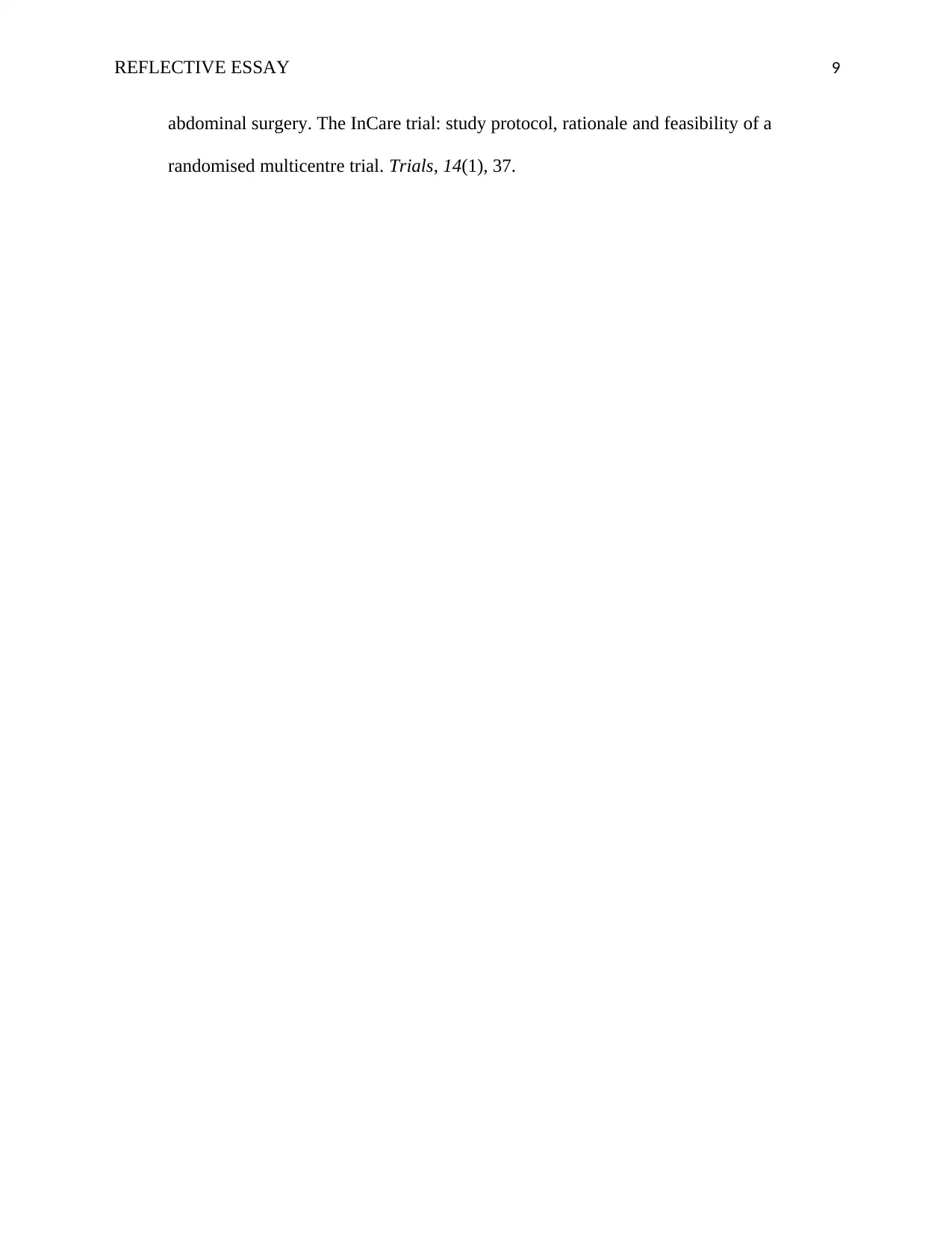
REFLECTIVE ESSAY 9
abdominal surgery. The InCare trial: study protocol, rationale and feasibility of a
randomised multicentre trial. Trials, 14(1), 37.
abdominal surgery. The InCare trial: study protocol, rationale and feasibility of a
randomised multicentre trial. Trials, 14(1), 37.
⊘ This is a preview!⊘
Do you want full access?
Subscribe today to unlock all pages.

Trusted by 1+ million students worldwide
1 out of 9
Related Documents
Your All-in-One AI-Powered Toolkit for Academic Success.
+13062052269
info@desklib.com
Available 24*7 on WhatsApp / Email
![[object Object]](/_next/static/media/star-bottom.7253800d.svg)
Unlock your academic potential
Copyright © 2020–2025 A2Z Services. All Rights Reserved. Developed and managed by ZUCOL.





